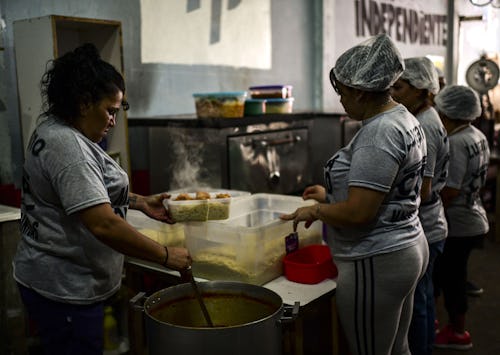
When you're reflecting on women of the past this March, consider the place of women in the modern world as well. The facts about women to remember during Women's History Month are eye-opening, alarming, and inspiring. Above all, they provide insight into the realities that many women are dealing with today.
Although many of the stats are relatively U.S.-centric, there are some facts that look at the global state of women as well. Educational and workplace equality are still concerns in many parts of the world. (On a happier note, most of the statistics coming out of the U.S. and around the globe concerning women’s education are trending positively.) Note that the COVID-19 quarantine could have shifted some of these statistics in the meantime, and it will probably take many more studies to determine exactly how the pandemic has affected women the world over.
Otherwise, the state of women in the modern world is both encouraging and enraging. But by taking a macro look at the trends, policies, and challenges that face today's women, you can get a better sense of the forces that govern our lives. There is still much work to be done, but so much has already been achieved.
Working Moms Are The Norm In U.S.

Over half of mothers with a child under the age of 1 are active in the labor force in the United States as of 2018, according to the U.S. Bureau of Labor Statistics. That number only increases as children age, and 76.4% of mothers with a child between the ages of 6 to 17 work.
Almost Half Of The U.S. Labor Force Is Female
Women made up 47.3% of the U.S. labor force in 2018, with over 78 million women workers, according to the U.S. Department of Labor. It’s been steadily increasing since 1920, when women made up 20.3% of the labor force.
Women Are A Huge Force In The World Of Philanthropy
Around 93% of high net worth women are involved in charitable giving, according to The 2018 U.S. Trust Study of High Net-Worth Philanthropy. Women are also more likely to support impact investing, which works to meet specific social or environmental goals while earning a financial gain. (Here’s how impact investing can help you make a difference in the world while making money, as reported in Bustle.)
Worldwide, Women Still Tend To Do The Majority Of Unpaid Labor
Across the globe, women typically complete far more unpaid domestic and care work than their male counterparts, often spending three times as many hours on it, according to The World’s Women 2020: Trends and Statistics report from the United Nations. Although the care these women are providing is often essential, these workloads can harm their abilities to participate in wage work.
Essential Worker Roles Frequently File As Women Of Color
Nursing assistants, home health aides, and emergency child care workers, which are often considered essential roles, are also among the top jobs for women of color, according to the Center for American Progress (CAP). In fact, almost one-third of all nursing assistants and home health aides are Black women, as the CAP further reports.
Worldwide Education Quality For Girls Is Improving
Across the world, both boys and girls are equally likely to receive primary education in most regions, according to The World’s Women 2020. Global literacy rates have also improved steadily over the past few years.
Women The World Over Are Marrying Later
In 1990, women entered a first marriage at the average age of 21.9, and that average rose to 23.3 years around 2010, according to Progress of the World’s Women from the UN. In fact, plenty of millennials tend to build a strong, years-long connection with their partner before considering marriage, according to Elite Daily.
Female Athletes Are Generally Well-Represented At The Olympic Games
Nearly 50 percent of athletes in the Olympic Games are female, and women have participated in every sport at the games since 2012, according to the Olympic Games. Any new sport joining the games must include a female division.
Younger Medical Doctors Are More Likely To Be Female
Over 60 percent of physicians under the age of 35 are female, according to a study of 18,000 physicians from Athena Health. And as of 2017, more women than men enrolled in U.S. medical schools, according to the Association of American Medical Colleges.
Female Leaders Are Slowly But Steadily On The Rise

Out of 193 countries, 21 have a woman as head of state or government, according to the Council of Foriegn Relations. Having more women in leadership is associated with greater efforts at promoting equality and social welfare, as well as increased stability for the country overall.
Women, Especially BIPOC Women, Are Underrepresented In The Arts
A survey of 18 major U.S. museums found that, of the artists represented, 87% are men and 85% are white, according to the study Diversity of Artists in Major U.S. Museums. Groups dedicated to boosting the place of female artists include the bitingly satirical Guerrilla Girls, as well as TILA Studios, which is focused on increasing representation of Black women in the fine arts industry.
Black Transgender Women Often Face The Brunt Of Violence Against Trans People
Of the 26 deaths attributed to violence against trans people in 2018, the majority of victims were Black transgender women, according to the Human Rights Campaign. There are many transgender rights organizations working to improve the lives of trans people and end the cycle of violence, according to Bustle.
Women Are Steadily Taking On More Senior Roles With Companies
From 2015 to 2020, the percent of women in senior vice president (SVP) roles grew from 23 to 28%, according to the Women in the Workplace report from LeanIn.org. Women in C-suite positions rose from 17 to 21%.
Women Rock The World Of Marathon Running
For 2019, around 43 percent of U.S. marathon runners were women, according to Marathon Statistics 2019 Worldwide. Of the 30 nations surveyed, the U.S. comes closest to gender parity for marathon participation.
Over Half Of All U.S. Accountants & Auditors Are Women
In the United States, 61.7% of all accountants and auditors are women, according to research from Catalyst. Globally, nearly half of all accounting students are female.
A Relatively High Number Of U.S. Women Are In Prison
Women in the United States account for only 4 percent of the world's female population, but U.S. women make up a staggering 30 percent of the world's population of women in prison, according to the Prison Policy Initiative. Nearly half of U.S. states incarcerate women at roughly 10 times the rate of international allies such as Portugal, Canada, and the United Kingdom
Breastfeeding Continues To Gain Popularity In The U.S.
Of U.S. infants born in 2017, 84% started off life breastfeeding, according to the Centers for Disease Control and Prevention (CDC). This is an increase from 2011, in which 79% of newborn infants began breastfeeding, according to the CDC. There’s a lot of potential benefits to giving your kid breast milk, including a lower need for dental work or chance of developing allergies later in life, according to Romper. That said, the Fed is Best Foundation acknowledges that strictly breastfeeding isn't ideal (or possible) for every mother, and advocates the normalization of formula feeding, as further reported in Romper.
Intimate Partner Violence Remains High
Worldwide, around 30 percent of women who've been in a relationship report experiencing physical and/or sexual violence from their partner, according to the World Health Organization. If you or a loved one is experiencing violence from a partner, contact the National Domestic Violence Hotline at 1.800.799.7233.
Heart Disease In Women Needs Far More Awareness
The leading cause of death for U.S. women, heart disease was responsible for approximately 1 out of every 5 female deaths in the United States in 2017, according to the CDC. Here’s the general symptoms of heart disease in women, as reported by Bustle, including chest discomfort and unusual fatigue. The good news is that you can help lower your risk of heart disease by quitting smoking, managing stress levels, and monitoring blood pressure, as further explained by the CDC. Talk to your doctor to learn more about things you can do now to help prevent heart disease.
In The U.S. Poverty Is More Likely To Affect Women

U.S. women are 35% more likely than men to face poverty, according to Legal Momentum. The wage gap, as well as a lack of affordable child care, contribute to this issue.
Same-Sex Attraction Occurs In Similar Numbers For Both Genders
In fact, 3.6% of men identify as gay or bisexual, compared to the 3.4% of women who identify as lesbian or bisexual, according to The Williams Institute at UCLA School of Law. In addition, women are more likely than men to identify as bisexual.
Women Make Up Over Half The Labor Force With A College Degree
As of 2019, women made up just over half of the U.S. labor market with a college degree, according to the Pew Research Center. This could mean positive things for womens’ overall earning power.
Paid Maternity Leave In The U.S. Is Far Below Average
When compared to 40 other nations, only the U.S. does not require any paid maternity leave, according to the Pew Research Center. Most other countries require at least two months of paid leave, as further noted by Pew Research. (Individual states or companies in the U.S. may provide more comprehensive maternity leave policies.)
Female CEOs At Major Companies Remain Rare
As of January 2020, women held 5.8% of CEO positions at S&P 500 companies, according to Catalyst. Women of color, those born outside the U.S., and LGBT women are especially underrepresented in these roles, as further explained in Catalyst.
Women Are Half The World's Population
In 2019, women made up 49.584% of the world’s population, according to The World Bank. Here's to the continued success, well-being, and care of all those individuals.
0 comments:
Post a Comment